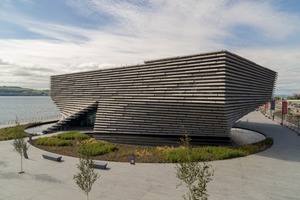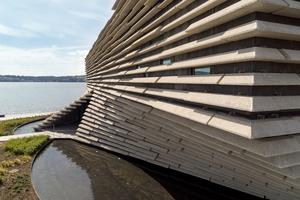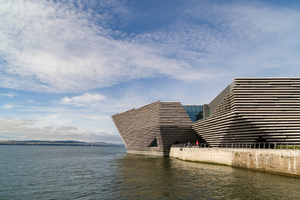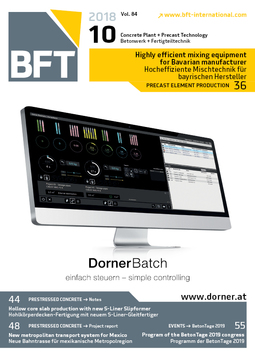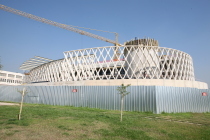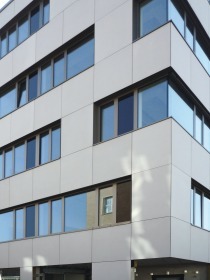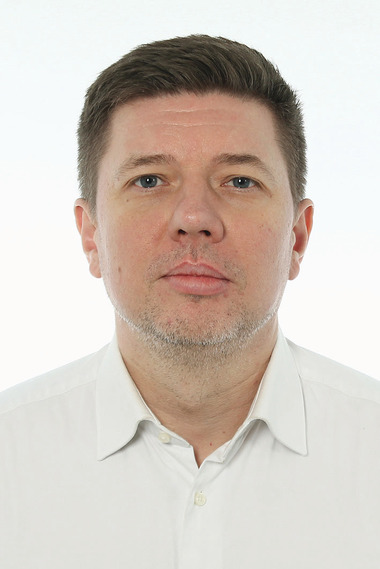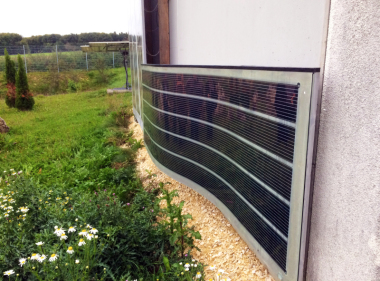Architectural concrete “façade of the year” for V&A Museum in Dundee
Situated on the River Tay, the Victoria & Albert Museum of Design Dundee (V&A Dundee) is the first V&A to be built outside London. The striking structure was designed by Japanese architect Kengo Kuma with BAM as the main contractor. It enjoys the enviable position as neighbor to the RSS Discovery which transported Shackleton and Scott on the Expedition to the Antarctic in 1901.
The design of the façade drew inspiration from the Scottish cliffs and the silhouette of the impressive façade imitates the shape of a ship at dock. Due to the complex geometric slopes and curvatures, coupled with its exposure to the Scottish weather and its proximity to the North Sea marine environment, architectural concrete was the favored material option for this project.
GPS enables installation with pinpoint precision
Techrete started design work on the £5.6m package of precast planks, which underwrite the design intent, in June 2015. BIM was utilized during this stage for the planks but more interestingly and innovatively it was used to accurately locate where the cast-in channels were to be placed in the walls to facilitate the precast fixings. A GPS system of precise co-ordinates was developed to ensure total accuracy of the interface between the cast-in channels and fixings on the panels during the installation process. There were approximately 18,000 channels cast in total. Pioneering bespoke fixings were also engineered by Techrete which contributed to the overall speed of installation. These fixings were specially designed with marine-grade materials to ensure there would be no corrosion due to its maritime location.
Due to the complexity of the curvature and complex geometric slopes of the façade mentioned previously, the manufacture of the molds, in itself, presented some challenges. From a distance, the planks look almost uniform, with a slightly non-linear appearance. The traditional mold manufacture process to facilitate such diversity in the planks would have proved very costly with a lot of wastage so Techrete experimented during the mock-up phase and initially toyed with the idea of devising a hydraulically driven adjustable mold. This method was examined and it was deemed economically prohibitive. Through an advanced design process and collaboration with a steel mold builder, a rotating steel mold was devised that enabled the mold to rotate on large rollers and had the capability to lock the form at given angles which were required for the diversity at the posterior of the units. The fully adjustable steel molds facilitated quick and easy mold changes, were simple to operate and adjust, and eliminated the need for a high volume of molds, thus reducing waste and improving quality.
C155 mix in an exposed finish
Careful consideration went into the choice of design mix. With such a detailed design brief for this structure, Techrete worked very closely at the design stage to agree a mix that would encompass all the elements detailed. The chosen mix was a C155 in an exposed finish. This mix encompasses all the design elements one would expect and draws heavily on the design intent to reflect the Scottish cliffs. The mix consists of reconstituted granite which drew direct inspiration from the rugged Scottish landscape and it was further decided to enhance this mix by exposing the aggregates with the use of a retarder during the production stage. This effect was further heightened with a light power washing.
The manufacturing period, which occupied approximately 15% of the production capacity, commenced in August 2016 and the duration was a year. Two months of preparatory site works were undertaken to ensure a seamless installation of the 8,787 linear meters of planks, ranging in weight from 0.9 to 2.8 t. The program was initially designed to install all planks in a 36-week period but due to the innovative GPS system of placing fixings, coupled with the preparatory site works and pioneering fixings, this was reduced to 28 weeks whilst on occasions installing up to 22 planks per day. Higher level planks were installed using mobile cranes but those on the lower levels, due to their underslung nature, had to be installed with a specialist bespoke lifting equipment designed by Techrete and their specialist lifting equipment supplier. The onsite installation commenced in March 2017 and was complete by the end of October 2017.
This project has already commenced collecting awards and was recently awarded the Façade of the Year title by the International design magazine, Wallpaper. The technical innovation displayed during design, production and installation further displays the versatility of concrete.

